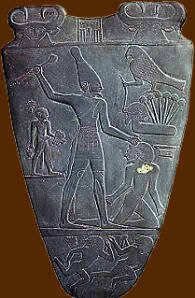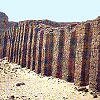|
|
|
the early dynastic period
At the end of the 4th millennium BC, Egyptian civilisation entered the historical record. Prior to this time, there had been the Predynastic Period, divided into various periods: The Badarian culture, with the earliest attested agriculture in Upper Egypt, and the Naqada culture, itself divided into the different phases of Naqada I (Amratian), Naqada II (Gerzean) and Naqada III.
|
It was probably during the Naqada III phase, the last phase of the predynastic period, (c.3200-3000 BC) that Egypt was first unified into a large territorial state.
The political fusion that laid the foundations for the Early Dynastic state of the 1st and 2nd Dynasties would have probably occurred at around this time.
|
|
There is in fact, evidence to suggest that there is a dynasty of kings which pre-dates the 1st Dynasty, now referred to as Dynasty 0. They were buried at Abydos, near the royal cemetery of the 1st Dynasty. There is considerable debate however to the precise nature of the process of unification, the date it took place, and the origins of Dynasty 0. |
Egyptian civilisation begins, according to Manetho, with the Unification of the Two Lands, Upper and Lower Egypt, under one king, traditionally known as Menes or Narmer (who may be the same person?). There also appears to be a king called Scorpion; together with Menes/Narmer, he is currently grouped in Dynasty 0.
Before the 4th Dynasty, pharaoh was usually known simply by his Horus Name. The name would be written in a "serekh" panel, with the Horus falcon standing on top. The first known "serekh" appears on the Narmer Palette.
Early dynastic pharaohs:
| DYNASTY 0 |
DYNASTY 1 |
DYNASTY 2 |
| Scorpion: named after the "Scorpion Macehead" which depicts King Scorpion as ruler of Upper Egypt. Little known. |
Hor-Aha: Horus name meaning "the fighting hawk". Narmer's successor. His greatest achievement was the founding of the capital city at Memphis. |
Hotepsekhemwy: Horus name meaning "pleasing in powers". Little known. According to Manetho, he reigned for 38 years, but there is little to show for it. |
| Narmer: Horus name meaning "striking catfish". Identified on the "Narmer Palette" and the "Narmer Macehead". Narmer is shown wearing the red and white crowns with his name in a serekh (pre-cartouche) |
Djer: Horus name meaning "Horus who succours". He succeeded Hor-Aha, and is said to have reigned for 57 years. His tomb at Abydos contains over 300 subsidiary burials of servants and retainers. |
Raneb: Horus name meaning "Re is the Lord". According to Manetho, he reigned for 38 years and introduced the worship of the sacred goat Mendes and the sacred bull Mnevis. |
|

Rear side of the Narmer Palette, shows Narmer wearing the white crown and striking down a foe.
|
Djet: Horus name meaning "Horus cobra". Buried in a tomb at Abydos which also contained 174 individual subsidiary sacrificial burials. |
Nynetjer: Horus name meaning "god-like". According to Manetho, he reigned for 47 years, during which little happened! |
| Den: Horus name meaning "Horus who strikes". Historical record becomes clearer, with many labels and inscriptions which cite this king and his reign. Buried at Abydos, his tomb also contains 174 subsidiary sacrificial burials. |
Sekhemib/Seth-Peribsen: Horus name meaning "powerful in heart", he then changed to a Seth name meaning "hope of all hearts". North-south rivalry led to a period of unrest, symbolised by the struggles of Horus v Seth. In this case it appears the followers of Seth triumphed. |
| Anedjib: Horus name meaning "safe is his heart". Reigned for 26 years according to Manetho. He is recorded as a Thinnite king on the Saqqara King List. His tomb at Abydos is one of the smallest, and contained 64 subsidiary burials. |
Khasekhemwy: Horus name meaning "the two powerful ones appear". He appears to be the last king of the dynasty, and managed to re-unite the followers of Horus and Seth. His huge tomb at Abydos is unique. |
| Semerkhet: Horus name meaning "thoughtful friend". Reigned for 9 years according to the Palermo stone, or 18 years according to Manetho! Possibility he was an usurper as he erased Anedjib's name from many stone vases. |
|
|
Qa'a: Horus name meaning "his arm is raised". May have reigned for 26 years? The practice of subsidiary burials appears to have stopped in the North during his reign. |
|
The royal tombs at Abydos and Saqqara
Each of the Early Dynastic tombs in the Royal Cemetery of Abydos was originally provided with a pair of carved stone funerary stelae, resembling tombstones.
 |
 |
The stelae would usually bear a hieroglyph called a "serekh" which represented the Horus name of the ruler. As well as the tombs at Abydos, there are some impressive tombs of high officials at North Saqqara. Some of these are very substantial, with elaborately niched mudbrick superstructures, and they are on the whole better preserved than the Abydos tombs.
|
| The Saqqara tombs show the early development of the tomb superstructure above ground, combined with an underground burial chamber. In the course of time, the design of these Saqqara tombs became even more elaborate, with a more complex arrangement of chambers. Unusual stepped mudbrick superstructures may also have been the early forerunners of the 3rd Dynasty Step Pyramids. |
 |
 |
Moving towards the "Old Kingdom" ...
The art, architecture and associated beliefs of the Old Kingdom unmistakably evolved from forms of the Early Dynastic period. The Step Pyramid complex of Djoser is a transformation of the Early Dynastic tombs into the world's first colossal scale monument made entirely of stone. This enormous monument clearly demonstrates the considerable level of control that the state had at this time, and it is this control which must have developed incrementally throughout the 1st and 2nd Dynasties following unification.
 |
Related pages: You can also read comprehensive articles on the Early Dynastic and Old Kingdom Periods in our "articles" page in the main site. |
|
|
|





